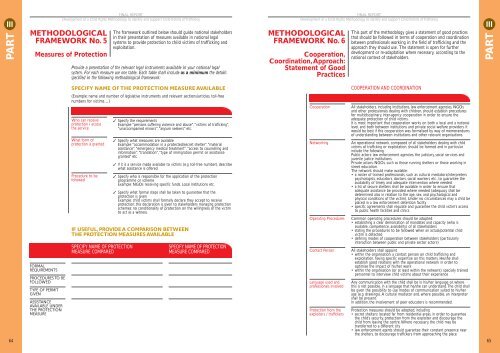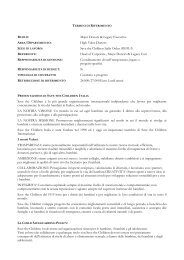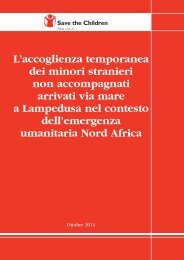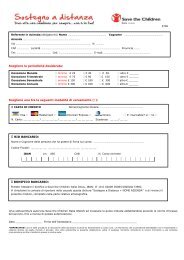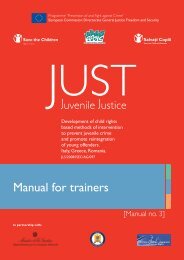IIIPART<strong>FINAL</strong> <strong>REPORT</strong>Development of a Child Rights Methodology to Identify and Support Child Victims of TraffickingMETHODOLOGICALFRAMEWORK No. 5Measures of ProtectionThe framework outlined below should guide national stakeholdersin <strong>the</strong>ir presentation of measures available in national legalsystems to provide protection to child victims of trafficking andexploitation.Provide a presentation of <strong>the</strong> relevant legal instruments available in your national legalsystem. For each measure use one table. Each table shall include as a minimum <strong>the</strong> detailsspecified in <strong>the</strong> following methodological framework:<strong>FINAL</strong> <strong>REPORT</strong>Development of a Child Rights Methodology to Identify and Support Child Victims of TraffickingMETHODOLOGICALFRAMEWORK No. 6Cooperation,Coordination,Approach:Statement of GoodPracticesThis part of <strong>the</strong> methodology gives a statement of good practicesthat should be followed in terms of cooperation and coordinationbetween professionals working in <strong>the</strong> field of trafficking and <strong>the</strong>approach <strong>the</strong>y should use. The statement is open for fur<strong>the</strong>rdevelopment or re-adaptation where necessary, according to <strong>the</strong>national context of stakeholders.IIIPARTSPECIFY NAME OF THE PROTECTION MEASURE AVAILABLECOOPERATION AND COORDINATION64FORMALREQUIREMENTSPROCEDURES TO BEFOLLOWEDTYPE OF PERMITGIVENASSISTANCEAVAILABLE UNDERTHE PROTECTIONMEASURE(Example: name and number of legislative instruments and relevant sections/articles, toll-freenumbers for victims…)Who can receiveprotection / access<strong>the</strong> serviceWhat form ofprotection is grantedProcedure to befollowed✓ Specify <strong>the</strong> requirementsExample: “persons suffering violence and abuse”, “victims of trafficking”,“unaccompanied minors”, “asylum seekers” etc.✓ Specify what measures are availableExample: “accommodation in a protected/secret shelter”, “materialassistance”, “emergency medical treatment”, “access to counselling andinformation”, “translation”, “type of immigration permit or assistancegranted” etc.✓ If it is a service made available to victims (e.g. toll-free number), describewhat assistance is offered✓ Specify who is responsible for <strong>the</strong> application of <strong>the</strong> protectionprogramme or schemeExample: NGOs receiving specific funds, Local Institutions etc.✓ Specify what formal steps shall be taken to guarantee that <strong>the</strong>protection is givenExample: child victims shall formally declare <strong>the</strong>y accept to receiveprotection; this declaration is given to stakeholders managing protectionschemes; no conditionality of protection on <strong>the</strong> willingness of <strong>the</strong> victimto act as a witness.IF USEFUL, PROVIDE A COMPARISON BETWEENTHE PROTECTION MEASURES AVAILABLESPECIFY NAME OF PROTECTIONMEASURE COMPAREDSPECIFY NAME OF PROTECTIONMEASURE COMPAREDCooperationNetworkingOperating ProceduresContact PersonLanguage used andprofessionals involvedProtection from <strong>the</strong>exploiters / traffickersAll stakeholders, including Institutions, law enforcement agencies, NGOsand o<strong>the</strong>r professionals dealing with children, should establish proceduresfor multidisciplinary, inter-agency cooperation in order to ensure <strong>the</strong>adequate protection of child victims.It is most important that cooperation works on both a local and a nationallevel, and both between institutions and private social welfare providers. Itwould be best if this cooperation was formalised by way of memorandumsof understanding between institutions and o<strong>the</strong>r relevant organisations.An operational network, composed of all stakeholders dealing with childvictims of trafficking or exploitation, should be formed and in particularinclude <strong>the</strong> following:Public actors: law enforcement agencies, <strong>the</strong> judiciary, social services andjuvenile justice institutions.Private actors: NGOs, such as those running shelters or those working instreet education.The network should make available:• a roster of trained professionals, such as cultural mediators/interpreterspsychologists, educators, doctors, social workers etc., to guarantee <strong>the</strong>availability of timely and adequate intervention where needed• a list of secure shelters shall be available in order to ensure thatadequate assistance be provided where needed (adequacy shall bedetermined also in relation to <strong>the</strong> age, sex, and psychological andphysical conditions of <strong>the</strong> victim). Under no circumstances may a child beplaced in a law enforcement detention facility• specific agreements shall regulate and guarantee <strong>the</strong> child victim’s accessto public health facilities and clinicsCommon operating procedures should be adopted:• establishing a clear demarcation of mandates and capacity (who isavailable, competence, availability) of all stakeholders• stating <strong>the</strong> procedures to be followed when an actual/potential childvictim is detected• defining modes of cooperation between stakeholders (particularlyinteraction between public and private sector actors)All stakeholders shall appoint• within <strong>the</strong> organisation: a contact person on child trafficking andexploitation, having specific expertise on this matters. He/she shallestablish good relations with <strong>the</strong> operational network in order tooptimise <strong>the</strong> impact of his/her work• within <strong>the</strong> organisation (or at least within <strong>the</strong> network): specially trainedpersonnel to interview child victims about <strong>the</strong>ir experienceAny communication with <strong>the</strong> child shall be in his/her language or, wherethis is not possible, in a language that he/she can understand.The child shallbe given <strong>the</strong> possibility to use modes of communication suited to his/herage (e.g. drawings). A cultural mediator and, where possible, an interpretershall be present.In addition, <strong>the</strong> involvement of peer educators is recommended.Protection measures should be adopted, including:• secret shelters: located far from residential areas, in order to guarantee<strong>the</strong> child’s security, protection from <strong>the</strong> exploiter and discourage <strong>the</strong>child from leaving <strong>the</strong> centre. Where necessary, <strong>the</strong> child may betransferred to a different city• law enforcement agents should guarantee <strong>the</strong>ir constant presence near<strong>the</strong> shelters, to discourage traffickers from approaching <strong>the</strong> place65
IIIPART<strong>FINAL</strong> <strong>REPORT</strong>Development of a Child Rights Methodology to Identify and Support Child Victims of TraffickingTraining of workersInformationThe in-depthinterview• Judicial officers should be empowered to confiscate child victim’s cellularphones in order to prevent <strong>the</strong>ir use by exploiters in exerting continuedcontrol over <strong>the</strong> childProfessionals working with potential victims should be specially trained onchildren’s rights, as well as trafficking, exploitation and tools and proceduresavailable for <strong>the</strong> child’s identification as a victim of trafficking and <strong>the</strong>ir support.Awareness raising and information materials on children’s rights alsoproviding useful contacts for child victims should be available in all locationswhere organisations and institutions within <strong>the</strong> network operate.Thematerials should be translated in languages which those childrenunderstand, and be visible.Where <strong>the</strong>re is <strong>the</strong> suspicion that a child is a victim of trafficking orexploitation, <strong>the</strong> child should be immediately referred to <strong>the</strong> professionalsresponsible for conducting an in-depth interview with <strong>the</strong> child.Theinterview must be conducted in accordance with <strong>the</strong> principles presentedin Section 3 of <strong>the</strong> AGIS methodology.Information ga<strong>the</strong>red in <strong>the</strong> interview must be confidential and not usedfor legal purpose (at least not before <strong>the</strong> child is in a position to providefree and informed consent in that regard). When <strong>the</strong> victim is a child, <strong>the</strong>consent shall be given in <strong>the</strong> presence of adults responsible for him/her,who can be a legal guardian appointed by <strong>the</strong> Judiciary.<strong>FINAL</strong> <strong>REPORT</strong>Development of a Child Rights Methodology to Identify and Support Child Victims of TraffickingMETHODOLOGICALFRAMEWORK No. 7Recommendations onOperating ProceduresThe methodological framework that follows shall guide <strong>the</strong>development of recommendations on operating procedures, ageassessment procedures and procedures to assess relations between <strong>the</strong>child and accompanying adults. Operating procedures are thoseapplicable at <strong>the</strong> border, on <strong>the</strong> street and o<strong>the</strong>r places wherevictims are exploited, in shelters and in <strong>the</strong> penal circuit.Although <strong>the</strong> first methodological framework below shall be usedfor <strong>the</strong> development of both operating procedures applicable at<strong>the</strong> border and operating procedures applicable on <strong>the</strong> street, ando<strong>the</strong>r places where victims are exploited, it is recommended todevelop a separate table for each set of procedures.The AGIS methodology recommends different colours be usedfor each location where operating procedures shall be applied: at<strong>the</strong> border, on <strong>the</strong> street or o<strong>the</strong>r places of exploitation, and placeswhere children are held, such as shelters and <strong>the</strong> penal circuit.This is done with a view to helping users find relevantinformation. To be consistent, <strong>the</strong> colours should correspond tothose used for Methodological Framework No. 2.IIIPARTThe scope of <strong>the</strong>in-depth interviewThe objective of <strong>the</strong> in-depth interview is not to ascertain facts or collectevidence in an investigative sense.Ra<strong>the</strong>r, it is intended to evaluate whe<strong>the</strong>r a child is a potential or actualvictim of trafficking or serious exploitation. When this is confirmed, <strong>the</strong>most suitable tools and mechanisms available for <strong>the</strong> child’s immediateprotection shall be activated.OPERATING PROCEDURES APPLICABLE AT BORDERSOPERATING PROCEDURES APPLICABLE ON THE STREETAND OTHER PLACES WHERE CHILDREN ARE EXPLOITEDAPPROACH TO BE USED BY PROFESSIONALSWORKING IN THE FIELDDetection ofunaccompanied child✓ Specify what procedures shall be followed if an unaccompanied child ora child accompanied by an adult without valid documents is detected at<strong>the</strong> border/on <strong>the</strong> street or o<strong>the</strong>r places where children are exploitedOverall approachtowards identificationGeneral approachtowards protectionand supportDealings withpotential victimsThe exploiterVictim’s possiblereactionsWhenever contact is made with a child (or someone who has just comeof age) who belongs to one of <strong>the</strong> groups at risk of trafficking, <strong>the</strong>y mustbe observed in light of <strong>the</strong> indicators of trafficking/exploitation described,and with a view to reading any signs that may assist <strong>the</strong> identification of <strong>the</strong>child as a victim of trafficking.Whenever <strong>the</strong> suspicion arises that a child (or someone just come of age)is a victim of trafficking or exploitation, <strong>the</strong> child must be treated as though<strong>the</strong>y are in fact a victim, and <strong>the</strong> relevant protection procedures (asprovided in <strong>the</strong> law or o<strong>the</strong>rwise) must be activated.The activation of suchprocedures must not be dependent on <strong>the</strong> child or young adult’scollaboration with authorities or o<strong>the</strong>r members of <strong>the</strong> network.When interacting with potential children at risk, aggressive orconfrontational behaviour as well as any sort of demonstration ofsuperiority or authority should be avoided. It is extremely inappropriate tomake deals with <strong>the</strong> child to obtain information that take advantage of<strong>the</strong>ir vulnerability to prosecution for certain crimes or repatriation (ordeportation, if <strong>the</strong>y are of age).Particularly in early stages, <strong>the</strong> exploiter should not be denigrated ordemonised, as <strong>the</strong>y often present <strong>the</strong>mselves as a very capable figure, andclose to <strong>the</strong> child.The “deconstruction” of this image often requires muchmore time, and often only occurs after <strong>the</strong> child has decided to activelyescape from <strong>the</strong> exploitative situation.To be taken into account:• it is normal for a child to take some time to acknowledge <strong>the</strong>ir status asa victim• prior to this self-awareness, aggressiveness or extreme hostility shown by<strong>the</strong> child towards o<strong>the</strong>rs are usually linked to <strong>the</strong> experience suffered• it is likely that <strong>the</strong> victim has suffered physical and/or psychological violence,which may have caused trauma that is difficult to identify and read• one of <strong>the</strong> typical reactions to this kind of trauma, is <strong>the</strong> difficulty ornear-impossibility (especially at <strong>the</strong> beginning) in coherently andchronologically recounting <strong>the</strong>ir life story to that pointAge assessmentIdentificationIn-depth interviewThe child is nota victim of trafficking:Information andproceduresInterim protection✓ Ensure <strong>the</strong> principle of <strong>the</strong> “benefit of <strong>the</strong> doubt” is respected, that is, incase of doubt <strong>the</strong>re should be a presumption that someone claiming to beless than 18 years of age, will provisionally be treated as such✓ Suggest which stakeholders are responsible for <strong>the</strong> application of <strong>the</strong>indicators of trafficking developed under <strong>the</strong> AGIS methodology andspecify <strong>the</strong> mandate each stakeholder must followExample: law enforcement agents with <strong>the</strong> support of NGOs areresponsible for assessing <strong>the</strong> application of indicators of trafficking tospecific cases.Where <strong>the</strong> indicators of trafficking apply to a specific case (see exampleabove):✓ Specify <strong>the</strong> procedures for referring a child to a specialised professionalresponsible for conducting <strong>the</strong> in-depth interview✓ Recommend <strong>the</strong> application of <strong>the</strong> ethical and methodological principlesapplicable in interviews presented in Section 3 of <strong>the</strong> AGISmethodologyIf <strong>the</strong> indicators of trafficking DO NOT apply to <strong>the</strong> specific case:✓ Specify <strong>the</strong> procedures that shall be implemented and <strong>the</strong> form ofprotection that will be granted to <strong>the</strong> child, first and foremost becausehe/she is a child (regardless of <strong>the</strong>ir nationality or immigration status)✓ Specify what materials can be provided to <strong>the</strong> child to inform him/herabout <strong>the</strong>ir rights and protection measures available✓ Specify what form of interim protection and care is available,considering that in all cases, any child has <strong>the</strong> right to receive it (e.g.emergency medical assistance, material assistance...)✓ Specify what referral mechanisms will be activated where a child isidentified as a victim of traffickingThe AGIS methodology recommends that a secure and secret sheltershall be contacted and a referral mechanism immediately implemented.6667


